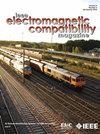Risk Assessment of Deep Brain Stimulator Implant Against Incident Lightning Electromagnetic Radiation
IF 2
3区 计算机科学
Q3 ENGINEERING, ELECTRICAL & ELECTRONIC
IEEE Transactions on Electromagnetic Compatibility
Pub Date : 2024-11-01
DOI:10.1109/TEMC.2024.3482170
引用次数: 0
Abstract
Deep brain stimulators (DBSs) have several therapeutic uses, including the treatment of movement and nonmovement disorders, and hence the global market for DBS implants is growing. Nevertheless, research has demonstrated that external electromagnetic fields interact with these implants within the human body, leading to variations in their operational state; several examples of these interactions have already been measured. However, clinical journal case studies have revealed that lightning strikes have notable consequences on active implants that have not yet been measured. Hence this article attempts to quantify the response of DBS implants when exposed to lightning electromagnetic fields (LEMFs). The field penetration into a homogeneous human body in and around the implant is quantified and undesirable variations in the stimulus output of DBS is measured. For a vicinity lightning strike at 10 m, peak value of penetrated electric field strength is computed to be 3.61 kV/cm and a magnetic field strength of 4.81 A/cm. Also an impulse current of 2 mA peak gets coupled along with the real time stimulus current pulse output of DBS, thus causing unbalanced charge injection into human tissue. Further study on various lightning strike distance affirmed an ineffective shielding of the implant and undesirable pick up of LEMF impulse by implant lead electrode.深部脑刺激器植入体对雷电电磁辐射的风险评估
本文章由计算机程序翻译,如有差异,请以英文原文为准。
求助全文
约1分钟内获得全文
求助全文
来源期刊
CiteScore
4.80
自引率
19.00%
发文量
235
审稿时长
2.3 months
期刊介绍:
IEEE Transactions on Electromagnetic Compatibility publishes original and significant contributions related to all disciplines of electromagnetic compatibility (EMC) and relevant methods to predict, assess and prevent electromagnetic interference (EMI) and increase device/product immunity. The scope of the publication includes, but is not limited to Electromagnetic Environments; Interference Control; EMC and EMI Modeling; High Power Electromagnetics; EMC Standards, Methods of EMC Measurements; Computational Electromagnetics and Signal and Power Integrity, as applied or directly related to Electromagnetic Compatibility problems; Transmission Lines; Electrostatic Discharge and Lightning Effects; EMC in Wireless and Optical Technologies; EMC in Printed Circuit Board and System Design.

 求助内容:
求助内容: 应助结果提醒方式:
应助结果提醒方式:


